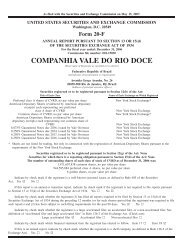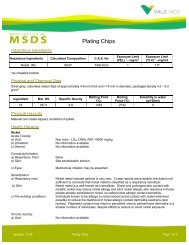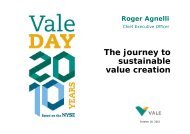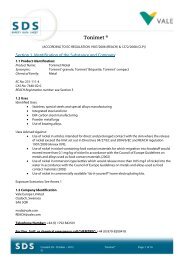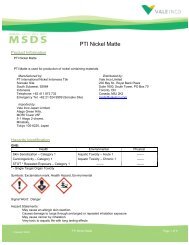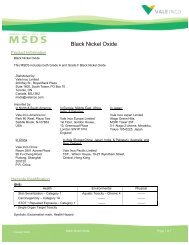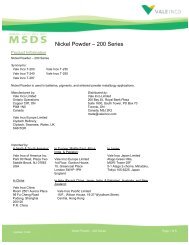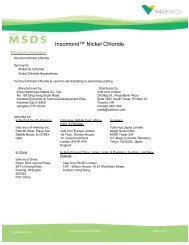Create successful ePaper yourself
Turn your PDF publications into a flip-book with our unique Google optimized e-Paper software.
<strong>Press</strong> <strong>Release</strong><br />
<strong>Vale</strong> approves capex budget for 2009<br />
Rio de Janeiro, October 16, 2008 - Companhia <strong>Vale</strong> do Rio Doce (<strong>Vale</strong>) announces that its Board of<br />
Directors has approved the investment budget for 2009, involving capital expenditures of US$ 14.2<br />
billion 1 dedicated to sustain existing operations and to foster growth through research and development<br />
(R&D) and the execution of projects in the several segments of our asset portfolio.<br />
Our investment budget clearly signals that project development is the priority of our growth strategy.<br />
In light of the risks posed by a challenging global economic environment, <strong>Vale</strong> retains the optionality to<br />
manage the development of its project pipeline according to the evolution of market conditions.<br />
Long-term fundamentals remain solid<br />
Despite the financial shock and its spillover into in the real economy, <strong>Vale</strong> is still confident of the longterm<br />
fundamentals of the minerals and metals markets.<br />
Global economic activity is decelerating and faces downside risks. In a globalized world, the<br />
performance of emerging market economies - the drivers of consumption of minerals and metals - is not<br />
insulated from the cycles of developed economies, as they are affected through the various trade and<br />
financial transmission channels. Notwithstanding the risks, emerging economies are expected to<br />
provide a source of resilience, benefiting from strong productivity growth and improved economic policy<br />
frameworks.<br />
Therefore, a more moderate growth is expected to take place over the next quarters in emerging<br />
economies, without causing disruption of their long-term growth process. The structural changes, which<br />
are determinants of the rapid increase of the consumption of minerals and metals, are an integral part of<br />
the long-term economic development and will keep evolving over the years ahead.<br />
Global market disequilibrium prevailing since 2003 has evidenced an increasing scarcity of mineral<br />
resources. The <strong>com</strong>bination of resource endowment restrictions coupled with institutional, cost and risk<br />
factors has prevented a meaningful response from the mining industry to price incentives. The financial<br />
shock and the ensuing credit supply slowdown imposes an additional and important restriction to<br />
growing the supply of minerals and metals, favoring large scale low-cost producers such as <strong>Vale</strong>.<br />
Ready to grow<br />
<strong>Vale</strong> has ample latitude to exploit the several profitable growth options available derived from its<br />
financial strength, rich stock of natural and human resources, <strong>com</strong>petitive costs and a long and<br />
successful track record in project development. We have been working along the past years to enhance<br />
each of these dimensions in order to continue to pursue the maximization of shareholder value creation.<br />
<strong>Vale</strong> enjoys a strong financial position based on its powerful cash flow generation, large cash holdings<br />
after raising US$ 12.2 billion with an equity issue, long-term credit lines from official credit institutions of<br />
approximately US$ 10.0 billion, medium-term revolving credit lines of US$ 1.9 billion, underleveraged<br />
balance sheet, average debt maturity of almost 10 years and the recent upgrade of its credit rating by<br />
Standard & Poor’s and Moody’s.<br />
1 The capex budget includes financial disbursements in consolidated format according to generally accepted US accounting principles (US<br />
GAAP). The main <strong>Vale</strong> subsidiaries consolidated according to US GAAP are: <strong>Vale</strong> Inco, MBR, Cadam, PPSA, Alunorte, Albras, <strong>Vale</strong>sul, <strong>Vale</strong><br />
Manganês S.A., RDME, RDMN, Urucum, Ferrovia Centro-Atlântica (FCA), <strong>Vale</strong> Australia, <strong>Vale</strong> International, and CVRD Overseas<br />
1
<strong>Press</strong> <strong>Release</strong><br />
Given its low cost operations and wealth of world-class assets, with large high-quality and long life<br />
mineral reserves, <strong>Vale</strong> is prepared to exploit its <strong>com</strong>petitive advantages, and is able to invest in<br />
increasing its exposure to the expansion in global demand for minerals and metals.<br />
We have been successful in retaining talented people and at the same time we have been investing<br />
heavily in the training of our human resources to guarantee an adequate stock of human capital to<br />
manage and to execute our growth and globalization processes.<br />
Despite a hostile global environment for cutting costs, we have managed to achieve some decrease<br />
over the last quarters. A more significant impact on cost reduction from our initiatives - changes in<br />
processes, restructuring of outsourced services, investments in logistics, energy and automation,<br />
dissemination of best practices and others- will be felt in the near future.<br />
<strong>Vale</strong> has been making strategic alliances with its main suppliers of parts, equipment and engineering<br />
services. Both directly and indirectly through supply guarantees and shorter lead times, these alliances<br />
will contribute to significantly reduce costs of investments for maintenance and expansion of our<br />
activities, thus fostering value creation.<br />
<strong>Vale</strong> has a long and successful track record in the development of a pipeline of diverse and large<br />
projects, as shown by the 26 projects delivered over the past years, involving mines, industrial plants<br />
and infrastructure. Alongside a history of excellence in project development, the focus on minimizing<br />
cost of capital and the discipline in its allocation has been key contributors to shareholder value<br />
creation.<br />
We have the awareness of the need to be prudent in face of the risks derived from the financial shock<br />
and its adverse feedback loops in the real economy. On the other hand, we do recognize the need to<br />
reconcile prudence with the exploitation of value-creating opportunities embodied in the potential for<br />
reducing capex costs arising from the current environment, thereby balancing growth with risk<br />
mitigation.<br />
In addition to the projects that are described in this press release, which have budgeted investment<br />
flows for 2009, several other organic growth options are available to us. Depending on our assessment<br />
of market conditions, these projects can be developed in the future.<br />
Based on the projects currently under development and the other organic growth options available, in a<br />
time span of five to seven years our iron ore production may surpass the 500 million metric tons mark,<br />
nickel output to reach 450,000 metric tons, copper one million metric tons, alumina 8.2 million metric<br />
tons, coal 40 million metric tons and the fertilizer business – potash and phosphate – may take a major<br />
boost. Expansion of our logistics infrastructure will take place in order to support the growth process.<br />
The implementation of the investment plan, supported by our values, large <strong>com</strong>petitive advantages and<br />
rigorous discipline in capital allocation, is expected to create significant shareholder value and multiple<br />
opportunities for economic and social mobility for the <strong>com</strong>munities where we develop our operations.<br />
The 2009 investment budget<br />
The program for 2009 involves investments of US$ 14.2 billion, with the execution of over 30 projects in<br />
Brazil, Canada, Mozambique, Oman, Australia, Indonesia, Chile and Peru, among others.<br />
Of the 2009 budget, US$ 11.652 billion will be invested in organic growth, corresponding to 81.8% of<br />
total spending, with US$ 10.178 billion allocated to project execution and US$ 1.473 billion to research<br />
and development (R&D).<br />
2
<strong>Press</strong> <strong>Release</strong><br />
Expenses with R&D include US$ 736 million set aside for our global mineral exploration program, US$<br />
510 million for conceptual, pre-feasibility and feasibility studies to develop mineral deposits already<br />
identified, and US$ 227 million to be invested in new processes, technological innovation and<br />
adaptation.<br />
We are investing in the exploration of iron ore, nickel, copper, bauxite, potash, phosphate, coal,<br />
uranium, and natural gas in over 20 countries in the Americas, Europe, Africa, Asia and Australia, to<br />
widen our future growth options.<br />
The exploration of uranium and natural gas is part of our strategic goal to optimize and diversify our<br />
energy matrix with a view to reducing costs and mitigating price and supply risks.<br />
The expenditures with conceptual, pre-feasibility and feasibility studies are the next step following a<br />
successful mineral exploration stage. The magnitude of these investments reflects the vast options for<br />
growth opportunities available to us. Meanwhile, the rise in funds set aside for investments in new<br />
processes, technological innovations and to adapt existing technologies is driven by our goal to<br />
continuously improve efficiency and maximize our <strong>com</strong>petitive advantages.<br />
The main projects in terms of financial disbursements in 2009 are: Carajás 130 Mtpy (US$ 798 million),<br />
Serra Sul (US$ 675 million), Tubarão VIII (US$ 527 million), Oman (US$ 458 million), Onça Puma (US$<br />
597 million), Salobo (US$ 459 million), CAP (US$ 405 million), Moatize (US$ 444 million), Bayóvar<br />
(US$ 279 million) and Barcarena (US$ 314 million).<br />
Six projects are expected to be concluded in 2009: Onça Puma, Southeastern Corridor, Additional<br />
10Mtpy, Carborough Downs, CSA, and Tres Valles 2 , while eight will be delivered in 2008. Amongst<br />
them, Zuhai, Samarco III, Fazendão, Dalian, Paragominas II and Alunorte 6&7 have already been<br />
delivered, while Vargem Grande I 3 and Goro will <strong>com</strong>e on stream by the end of the year.<br />
Investments to sustain existing operations are estimated at US$ 2.584 billion, which represents 4.3% of<br />
our asset base in June 2008.<br />
US$ 4.785 billion will be invested in non-ferrous minerals, representing 33.6% of the total capex for<br />
2009, while ferrous minerals will receive investments of US$ 4.179 billion, 29.4% of total capex.<br />
Expenditures in infrastructure include US$ 822 million in power generation and US$ 3.027 billion in<br />
logistics, in which the bulk will be dedicated to support our plans to expand our iron ore production<br />
capacity. We plan to invest US$ 808 million in the coal business in 2009, which involves mainly the<br />
expansion of Carborough Downs and the development of the Moatize mine.<br />
2 Tres Valles is now the name of the former Papomono project, which envolves a new copper mine in Chile, with na annual production capacity<br />
of 18.000 metric tons of copper cathode.<br />
3 Vargem Grande is now the name of the former Itabiritos project, which involves the construction of a pelletizing plant with an annual<br />
production capacity of 7 million metric tons in the Brazilian state of Minas Gerais.<br />
3
<strong>Press</strong> <strong>Release</strong><br />
INVESTIMENT BUDGET - US$ million<br />
By category 2009 %<br />
Organic growth 11,652 81.8%<br />
Projects 10,178 71.5%<br />
R&D 1,473 10.3%<br />
Support of existing operations 2,584 18.2%<br />
Total 14,235 100.0%<br />
By business area 2009 %<br />
Ferrous minerals 4,179 29.4%<br />
Non-ferrous minerals 4,785 33.6%<br />
Logistics 3,027 21.3%<br />
Coal 808 5.7%<br />
Power Generation 822 5.8%<br />
Steel 357 2.5%<br />
Others 257 1.8%<br />
Total 14,235 100.0%<br />
Focus on corporate social responsibility<br />
In line with our strategic priorities, investments in corporate social responsibility in 2009 will amount to<br />
US$ 900 million, 19.2% above the expenditures planned for 2008.<br />
<strong>Vale</strong> plans to invest US$ 641 million in 2009 in protection and conservation of the environment, a 34.9%<br />
increase in <strong>com</strong>parison to the 2008 budget of US$ 475 million. The disbursements programmed for<br />
social projects reach US$ 259 million, against US$ 280 million budgeted for 2008.<br />
Project development in 2009<br />
Ferrous minerals – profitable growth with structural changes<br />
Simultaneously to the planned expansion of our iron ore production capacity, our investments will<br />
involve some structural changes.<br />
A major part of the planned expansion will be ac<strong>com</strong>plished through the execution of greenfield projects<br />
in Carajás, including investments in new mines, processing plants and, particularly, in logistics infrastructure.<br />
Given the very large volumes to be carried, a highly efficient logistics system is extremely<br />
important for the <strong>com</strong>petitiveness of the iron ore operations.<br />
The capex cost per metric ton of new capacity will increase <strong>com</strong>pared to brownfield projects delivered in<br />
the past years, such as Fábrica Nova, Capão Xavier and Brucutu, as a consequence of the large<br />
investments in logistics. On the other hand, the new projects will contribute to reduce average<br />
operational costs and to improve the average quality of iron ore output, while the expansion in<br />
infrastructure allows for future production capacity increases at much lower costs.<br />
In order to strengthen our <strong>com</strong>petitive position in the global market, we will invest in the downstream of<br />
iron ore and logistics operations, including pelletizing plants - in Brazil, the Middle East, Southeast Asia<br />
and China - maritime transportation, distribution centers - in the Middle East, Southeast Asia and China<br />
- and steel plants in Brazil.<br />
4
<strong>Press</strong> <strong>Release</strong><br />
Due to the deterioration in iron ore quality worldwide, our investments to increase Carajás iron ore<br />
production and to build new pellet plants seek to capture the higher value in products that contain a<br />
superior “value-in-use” for the steel industry.<br />
The creation of a dedicated maritime shuttle service between Brazil and Asia is part of the logistics<br />
solution for the iron ore business between our maritime terminals and Asian clients, and will contribute<br />
to reduce the cost volatility of this product for the steelmakers, enhancing our <strong>com</strong>petitiveness. Asia is<br />
the largest market for iron ore and is expected to remain as the main driver of future demand growth.<br />
The creation of iron ore regional distribution centers will give us more operational flexibility, making it<br />
easier to penetrate domestic markets, thus shifting the boundaries of the seaborne market.<br />
Regarding the steel industry, our strategy is to hold temporary stakes in steelmaking projects in Brazil,<br />
obtaining in exchange long term contracts to supply all iron ore or pellets needed for these operations.<br />
Carajás 130 Mtpy will add 30 Mtpy to the current capacity of the northern range of Carajás and has an<br />
estimated capex of US$ 2.478 billion. It involves the installation of a new beneficiation plant and<br />
investments in logistics assets (car dumpers, stockyards, and terminals). The expected start-up has<br />
been postponed to 1H11, depending on obtaining the environmental licenses. For 2009, the capex<br />
budget is US$ 798 million.<br />
In order to partially <strong>com</strong>pensate for the delay of Carajás 130 Mtpy, Additional 10 Mtpy, a brownfield<br />
project, is being developed in the northern range of Carajás. The capex cost per ton is relatively low,<br />
US$ 29, as the project mainly involves the increase in the capacity of iron ore beneficiation. The<br />
operation start-up is scheduled for the second half of 2009 and US$ 84 million will be spent in 2009.<br />
Serra Sul, the largest greenfield project in the history of <strong>Vale</strong> and also in the iron ore industry, will add in<br />
its initial phase 90 Mtpy to our production capacity. The cost of investment was revised to US$ 11.297<br />
billion from US$ 10.094 billion. The bulk of the cost increase is due to the larger scope of the logistics<br />
infrastructure. The advance in engineering projections resulted in an increased number of equipment to<br />
be bought, new rail paths to be duplicated, and one hump yard.<br />
As the project is still in a preliminary phase of development, there is potential to cut its capex costs - a<br />
goal we are strongly pursuing.<br />
In addition to the development of the new mine, a large dry beneficiation plant with processing capacity<br />
of 90 Mtpy will be built. Serra Sul is a logistics intensive project: US$ 7.752 billion - 68.6% of the total<br />
capex - will be invested on the railroad and maritime terminal. They en<strong>com</strong>pass the duplication of 546<br />
km of the EFC railroad, construction of a 104 km rail branch, crossing yards, bridges, overpasses,<br />
tunnels, loading area, purchase of 5,540 wagons and 70 lo<strong>com</strong>otives, new car dumpers, stockyards,<br />
stocking and loading equipment, load lines, ship loaders and the fourth pier with two berths in the Ponta<br />
da Madeira maritime terminal.<br />
The conclusion of Serra Sul is expected for the second half of 2012. In 2009, investments will total US$<br />
675 million. The project is subject to approval by the Board of Directors.<br />
In the Southeastern System, investments allocated to the Apolo project, previously named Maquiné-<br />
Baú, were revised to US$ 2.509 billion from US$ 2.207 billion. The project will have a production<br />
capacity of 24 Mtpy with start-up scheduled for the first half of 2013. The project is subject to approval<br />
by the Board of Directors.<br />
To support the transportation of iron ore produced in the Southeastern System we are developing the<br />
Southeastern Corridor project to expand the capacity of the Vitória a Minas Railroad (EFVM) and the<br />
5
<strong>Press</strong> <strong>Release</strong><br />
port of Tubarão. The conclusion of this project is expected for 1H09. Total investment for 2009 is US$<br />
163 million.<br />
Tubarão VIII will be the eighth pelletizing plant at the port of Tubarão, in Vitória, in the state of Espírito<br />
Santo, with start-up scheduled for the second half of 2010 and production capacity of 7.5 Mtpy. The<br />
total cost of the project is US$ 636 million. In 2009, investments are planned to reach US$ 527 million.<br />
The Oman project en<strong>com</strong>passes the construction of a pelletizing plant with production capacity of 9<br />
Mtpy of direct reduction pellets and a distribution center with capacity to handle 40 Mtpy at the Sohar<br />
port in Oman. The total capex is US$ 1.356 billion, with investments of US$ 458 million for 2009. The<br />
start up is planned for the 2H10.<br />
We are also investing in the construction of 12 very large ore carriers (VLOCs), each one with a<br />
capacity of 400,000 deadweight tons (dwt), the world’s largest ore carriers. The total cost is US$ 1.650<br />
billion and the disbursement in 2009 will be US$ 154 million. The delivery of the first of these vessels is<br />
scheduled for the first half of 2011 and the <strong>com</strong>pletion of the order is expected to take place in the<br />
following year.<br />
The increase in iron ore sales in Brazil, a country that has considerable <strong>com</strong>parative advantages in steel<br />
production, will be expedited through investments in steel plants associated with large global steel<br />
producers.<br />
The ThyssenKrupp CSA (CSA) plant is under construction, while three other projects are currently<br />
under feasibility studies - Baosteel CSV (CSV), Companhia Siderúrgica de Pecém (CSP) and Aços<br />
Laminados do Pará (Marabá).<br />
CSA will produce 5 million metric tons of steel slabs in a plant under construction in the state of Rio de<br />
Janeiro, Brazil, demanding 8.5 million metric tons of iron ore and pellet per year to be exclusively<br />
supplied by <strong>Vale</strong>. Start-up is scheduled for the second half of 2009. <strong>Vale</strong> total investment in the project<br />
will be US$ 630 million, of which US$ 139 million to be disbursed in 2009.<br />
<strong>Vale</strong> is participating in an integrated slab plant project (CSV), with initial production capacity of 5 million<br />
metric tons per year, in a joint venture with Baosteel, the largest steel producer in China. <strong>Vale</strong>´s stake in<br />
the total capital of CSV will be 20%, with associated investments of US$ 1.046 billion, and an estimated<br />
disbursement of US$ 65 million for 2009.<br />
The plant will be located in Ubú, in the municipality of Anchieta, in the Brazilian state of Espírito Santo,<br />
and the project, which is still subject to approval by the Boards of Directors of <strong>Vale</strong> and Baosteel, is<br />
expected to start up in the second half of 2012.<br />
Associated to the CSV project, we are investing in a new railroad, Litorânea Sul, which will be 165 km<br />
long and will serve the Anchieta industrial <strong>com</strong>plex and a new port to be built in Ubú. The estimated<br />
total cost of this project, which is still subject to Board of Directors approval, has been revised to US$<br />
935 million after the development of the engineering stage. The conclusion is scheduled for the first half<br />
of 2012, with planned disbursement for 2009 totaling US$ 107 million.<br />
In partnership with Dongkuk Steel and JFE Steel Corporation, <strong>Vale</strong> is studying a project to build a steel<br />
slab plant in the Brazilian state of Ceará with a production capacity up to 6 million metric tons per year<br />
(CSP). According to the plans, our stake in CSP capital is expected to be 20%, which would result in an<br />
estimated investment of US$ 1.004 billion. The development of this project is pending the conclusion of<br />
feasibility studies and the approval of its shareholders.<br />
<strong>Vale</strong> will also invest in the construction of a steel plant, in Marabá, state of Pará, Brazil, with production<br />
capacity of 2.5 million metric tons per year of semi-finished steel, which will involve an estimated<br />
6
<strong>Press</strong> <strong>Release</strong><br />
investment of US$ 3.3 billion and start up expected for 2013. The feasibility study is currently being<br />
conducted and investment expected for 2009 is US$ 43 million. The project is subject to Board of<br />
Directors approval.<br />
Non –ferrous minerals – profitable growth with diversification<br />
<strong>Vale</strong> has the availability of significant and very attractive growth options in nickel, bauxite, alumina,<br />
copper and fertilizers.<br />
We are the mining <strong>com</strong>pany with the highest potential for nickel production growth, given the size and<br />
quality of proven and probable reserves – the world’s largest – and our global portfolio of projects in<br />
Brazil, Canada, New Caledonia and Indonesia.<br />
<strong>Vale</strong> is concluding Goro, in New Caledonia, and Onça Puma, Brazil. Given their respective ramp-ups,<br />
we expect Goro output to begin to be delivered to the market in 2Q09 while Onça Puma only in 3Q09.<br />
Onça Puma is built on deposits of nickel laterites saprolites in the state of Pará, Brazil, and expected to<br />
reach a nominal capacity of 58,000 tpy of nickel contained in ferronickel, its final product. The<br />
investment for this project is estimated at US$ 2.297 billion, with US$ 597 million allocated to 2009.<br />
Onça Puma is expected to <strong>com</strong>e on stream in the first half of 2009.<br />
The development of Totten, in Sudbury, Canada, has already started. Vermelho, in Carajás, Brazil, was<br />
postponed in order to reevaluate the process and technology so as to exploit more efficiently its<br />
reserves. Meanwhile, we have started the feasibility study of Piauí, state of Piauí, Brazil.<br />
We will disburse US$ 112 million in 2009 for the development of Totten, in Sudbury, Ontario, Canada, a<br />
century-old mineral province rich in nickel sulfide with numerous by-products. The purpose of the<br />
project is the re-opening of the Totten mine, closed in 1972, to produce 13 million metric tons of ore with<br />
an average grade of 1.33% Ni, 1.81% Cu and 0.120 oz of precious metals per metric ton, over a 20-<br />
year period. The total cost is estimated at US$ 362 million, with <strong>com</strong>pletion forecast for the first half of<br />
2011. The new mine will have a nickel-producing capacity of 8,200 tpy with copper and precious metals<br />
as by-products.<br />
The expansion of the Clarabelle Mill, the processing plant in Sudbury, yet to be approved by the Board,<br />
consists of increasing ore beneficiation capacity, while improving the nickel and copper recovery rates.<br />
The estimated total cost is US$ 1.272 billion and the capex budgeted for 2009 is US$ 50 million. We<br />
estimate the conclusion to happen in the second half of 2011.<br />
Aiming to reduce nickel production costs, we are investing in the CC Deep project, which involves the<br />
replacement of the two current shafts in the Copper Cliff North and Copper Cliff South mines, in<br />
Sudbury, by one single shaft, along with the associated infrastructure. The new operation will enable a<br />
reduction of 25% in the operating costs and deeper exploration of the mine to 5,200 feet. The estimated<br />
total investment is US$ 814 million, of which US$ 138 million is expected for 2009. Start-up is forecast<br />
for the first half of 2013.<br />
Pursuant to an agreement with the Government of the Province of Newfoundland and Labrador, we will<br />
build a <strong>com</strong>mercial nickel processing facility in Newfoundland and Labrador to produce 50,000 metric<br />
tons of finished nickel per year, together with up to 5,000 metric tons of copper and 2,500 metric tons of<br />
cobalt, utilizing the ore from the Ovoid mine in our Voisey Bay mining site. The decision about the<br />
technology to be employed in this project will be made at the end of this year. The investment is subject<br />
to Board approval.<br />
At the moment, nickel concentrates produced at the Voisey’s Bay facilities are sent for smelting and<br />
refining to our operations in Thompson, Manitoba, and Sudbury, Ontario, while the copper concentrate<br />
is shipped directly to clients.<br />
7
<strong>Press</strong> <strong>Release</strong><br />
In our operations on the Island of Sulawesi, Indonesia, a third hydroelectric power plant, Karebbe,<br />
located on the Larona River, which will supply 90 MW, is under construction. This project will eliminate<br />
the use of diesel generators that currently <strong>com</strong>plement the power generation required by the operations.<br />
In addition to the cost reduction in an energy intensive operation (nickel laterite saprolite), Karebbe will<br />
enable the production of 90,000 tpy of nickel-in-matte in Sorowako, providing an increase of its nominal<br />
capacity. The total capex is estimated at US$ 410 million, with US$ 119 million to be disbursed in 2009.<br />
Karebbe is expected to <strong>com</strong>e on stream in the second half of 2010.<br />
Goro, Onça Puma and Totten will produce additional new nominal capacity while Clarabelle Mill, CC<br />
Deep and Karebbe will contribute to cost reduction and productivity increases. However, depending on<br />
the nickel price environment we have the option to extend the duration of the projects ramp up and/or<br />
postpone their conclusion.<br />
<strong>Vale</strong> has two copper projects under development: Salobo, in Brazil, and Tres Valles (formerly<br />
Papomono), in Chile. The operation of the hydro-metallurgic plant (UHC) has begun and the Board of<br />
Directors has approved the expansion of the Salobo project.<br />
UHC is testing the application of hydro-metallurgical technology CESL on an industrial scale. The patent<br />
for this technology was acquired by <strong>Vale</strong>, with a view to the processing of more <strong>com</strong>plex copper<br />
minerals to produce copper cathodes. The confirmation of positive results obtained in previous tests<br />
developed in a pilot plant will make feasible the development of one Carajás project with potential to<br />
produce up to 160,000 metric tons of copper.<br />
In the first phase of development of the Salobo copper deposit in Carajás, state of Pará, Brazil, the<br />
nominal capacity was expanded to 127,000 tpy of copper contained in concentrate, with 130,000<br />
ounces of gold per year as a by-product. The concentrate will be processed using conventional<br />
smelting technology. The capex for the project is estimated at US$ 1.152 billion, including US$ 459<br />
million in 2009. Salobo is scheduled to <strong>com</strong>e on stream in the first half of 2010.<br />
At the same time, we are developing an expansion of Salobo, which will boost the beneficiation capacity<br />
to 24 from 12 Mtpy of ROM, with an additional output of 127,000 metric tons of copper in concentrate<br />
per year. The scope of the project contemplates the expansion of the industrial and support facilities,<br />
raising the height of the tailing dam and increasing mine movement. The estimated total capex is US$<br />
855 million, of which US$ 39 million will be disbursed in 2009. The conclusion of this expansion is<br />
scheduled for the second half of 2011.<br />
Tres Valles, in the Coquimbo region of Chile, will have an estimated nominal production capacity of<br />
18,000 tpy of copper cathode, using a SX-EW (solvent extraction electrowinning) processing plant. The<br />
total cost of the project is US$ 102 million, with a disbursement for 2009 of US$ 56 million and<br />
scheduled conclusion for the second half of 2009.<br />
<strong>Vale</strong>’s strategy for the aluminum business is focused on the organic growth of upstream assets, through<br />
the development of its high quality bauxite reserves and the very efficient low-cost alumina operations.<br />
As recently announced, we will build a new alumina refinery, Companhia de Alumina do Pará (CAP),<br />
and expand our Paragominas bauxite mine (Paragomias III), both located in the Brazilian state of Pará.<br />
CAP will be responsible for the implementation and operation of an alumina refinery, located in<br />
Barcarena, close to the alumina refinery of our subsidiary Alunorte. CAP will be 80% owned by <strong>Vale</strong>,<br />
and 20% by Hydro Aluminium.<br />
The initial production capacity of the refinery will be 1.86 Mtpy of alumina, through two lines of 930,000<br />
tpy each. The new refinery has potential for future capacity expansions up to 7.4 Mtpy.<br />
8
<strong>Press</strong> <strong>Release</strong><br />
The estimated total capex for phase one of CAP is US$ 2.2 billion. The project implementation is<br />
beginning this month and the operation start-up is expected to take place in the first half of 2011. The<br />
estimated disbursement for 2009 is US$ 405 million.<br />
Paragominas III will supply the bauxite to be consumed by the CAP refinery. The estimated total capex<br />
is US$ 487 million, of which US$ 81 million in 2009, and it will increase the capacity of our Paragominas<br />
mine to 14.85 from the current 9.9 Mtpy. Paragominas III is expected to start up operations<br />
simultaneously with the first stage of CAP, in the first half of 2011.<br />
We are developing the Bayóvar phosphate deposit, in Peru, and studying potash projects in Brazil<br />
(Carnalita) and Argentina (Neuquén).<br />
Bayóvar involves an open-pit mine in the district of Sechura, Province of Piura, Peru, with nominal<br />
production capacity of 3.9 Mtpy of phosphoric concentrate, and a maritime terminal. The main<br />
implementation license was already obtained. Estimated total capex is US$ 479 million, with expenses<br />
of US$ 279 million in 2009. Conclusion is planned for the second half of 2010.<br />
<br />
Coal – building a new business<br />
In the first half of 2007 we acquired coal assets in Australia. Currently, we are managing the ramp up of<br />
these operations and intending to continue to invest in order to build a coal business with a global scale<br />
and <strong>com</strong>petitiveness similar to our other mining businesses. The 2009 budget plans capital<br />
expenditures of US$ 808 million for the coal operations.<br />
We are investing in the expansion of the Carborough Downs underground mine, in Central Queensland,<br />
Australia. This project will increase nominal capacity to 4.8 Mtpy by 2011, from the current capacity of<br />
1.0 Mtpy. The estimated capex is US$ 330 million, of which US$ 138 million will be invested in 2009.<br />
<strong>Vale</strong> has obtained all the required licenses from the Government of Mozambique for the construction of<br />
the Moatize mine, in the province of Tete. Moatize will have a nominal production capacity of 11.0 Mtpy:<br />
8.5 Mtpy of metallurgical coal and 2.5 Mtpy of thermal coal. The construction start-up is pending the<br />
conclusion of negotiations involving railroad transportation and port handling services. We estimate that<br />
construction will take 36 months. The estimated total cost of this project is US$1.398 billion, with<br />
expenses of US$ 444 million in 2009.<br />
In sum, coal is an industry in which we definitely want to be a major global player.<br />
<br />
Power generation – enhancing the infrastructure<br />
Energy management and generation is a key priority. As a large consumer of energy, we believe that<br />
investing in power generation to meet our consumption needs is an efficient way to protect against price<br />
volatility, regulatory uncertainties and supply risks.<br />
Currently, we generate 25% of our global electricity consumption from our own power plants located in<br />
Brazil, Canada and Indonesia.<br />
We are investing in the construction of three power plants: Karebbe, in Indonesia, a hydroelectric power<br />
plant dedicated to our nickel operations in Sorowako, Barcarena, a coal fired power plant, and Estreito,<br />
a hydropower plant, both in Brazil.<br />
The Barcarena thermal power plant, located in the Brazilian state of Pará, will have an installed capacity<br />
of 600MW. The project is 100% owned by <strong>Vale</strong>. Completion is targeted for the second half of 2011. This<br />
9
<strong>Press</strong> <strong>Release</strong><br />
plant will consume 1.8 Mtpy of thermal coal and the estimated total investment in the project is US$ 898<br />
million, US$ 314 million of which will be spent in 2009.<br />
The Estreito hydroelectric power plant, located on the Tocantins River, on the border of the Brazilian<br />
states of Maranhão and Tocantins, will have an installed capacity of 1,087 MW. Estreito is expected to<br />
<strong>com</strong>e on stream in the second half of 2010. We own a 30% stake in the consortium that has the<br />
concession to build and operate the plant. Our estimated share of the total investment is US$ 514<br />
million, with US$ 149 million to be disbursed in 2009.<br />
We aim to diversifying and optimizing our energy matrix by using hydropower and thermal coal, seeking<br />
to identify natural gas deposits in Brazil and uranium deposits in Canada and Australia, and studying the<br />
usage of renewable fuels, such as biodiesel.<br />
Description of the main projects<br />
Business<br />
Ferrous<br />
Minerals/<br />
Logistics<br />
Project<br />
Carajás 130<br />
Mtpy<br />
Carajás –<br />
additional 10<br />
Mtpy<br />
Budget<br />
US$ million<br />
Status<br />
2009 Total<br />
798 2,478 This project will add 30 Mtpy to current capacity. It <strong>com</strong>prises<br />
investments in the installation of a new plant, <strong>com</strong>posed of primary<br />
crushing, processing and classification units and significant<br />
investments in logistics. The purchase of equipment and work on the<br />
fourth car dumper and stockyards is already under way. Start-up<br />
planned for 1H11, depending on concession of environmental<br />
licenses.<br />
84 290 This project will add 10 Mtpy of iron ore to the current capacity. It<br />
involves investment the overhauling of a dry plant and the acquisition<br />
of a new one. Start-up expected for 2H09.<br />
Carajás Serra<br />
Sul<br />
675 11,297 Located on the Southern range of Carajás, in the Brazilian state of<br />
Pará, this project will have a capacity of 90 Mtpy. Completion is<br />
scheduled for 2H12 subject to obtaining the environment licenses. The<br />
project is still subject to approval by the Board of Directors.<br />
Apolo 54 2,509 Project in the Southern System with a production capacity of 24 Mtpy<br />
of iron ore. Start-up expected for 1H13. The project is still subject to<br />
approval by the Board of Directors.<br />
Southeastern<br />
Corridor<br />
163 553 Expansion of the Vitória a Minas Railroad (EFVM) and the port of<br />
Tubarão. The fifth car dumper is working at full capacity and the ship<br />
loaders are being assembled in China. Conclusion planned for 1H09.<br />
Tubarão VIII 527 636 Pelletizing plant to be built at the port of Tubarão, in the Brazilian state<br />
of Espírito Santo, with a 7.5 Mtpy capacity. Civil engineering work has<br />
started. Project being implemented with <strong>com</strong>pletion scheduled for<br />
2H10.<br />
Oman 458 1,356 Project for the construction of a pelletizing plant in the Sohar industrial<br />
district, Oman, in the Middle East, for the production of 9 Mpty of<br />
direct reduction pellets and a distribution center with capacity to<br />
handle 40 Mpty. Start up planned for 2H10.<br />
10
<strong>Press</strong> <strong>Release</strong><br />
Litorânea Sul 107 935 The Litôranea Sul Railroad will be 165 kilometers long and will give<br />
access to the port of Ubu in the state of Espírito Santo. Completion of<br />
investments is scheduled for 1H12. Subject to approval by the Board<br />
of Directors.<br />
Onça Puma 597 2,297 The project will have a nominal production capacity of 58,000 metric<br />
tons per year of nickel in ferronickel form, its final product. Civil<br />
engineering work concluded and electromechanical assembly under<br />
way. Conclusion planned for 1H09.<br />
Totten 112 362 Mine in Sudbury, Canada, aiming to produce 8,200 tpy of nickel,<br />
copper and precious metals as by-products. Project being<br />
implemented and conclusion planned for 1H11.<br />
Non-<br />
Ferrous<br />
Minerals<br />
Karebbe 119 410 Karebbe hydroelectric power plant in Sulawesi, Indonesia aims to<br />
supply 90MW for the Indonesian operations, targeting production cost<br />
reduction by substitution of oil as fuel. Work started and main<br />
equipment purchased. Scheduled to start up in 2H10.<br />
Salobo 459 1,152 The project will have a production capacity of 127,000 metric tons of<br />
copper in concentrate. Project implementation under way and civil<br />
engineering has started. Conclusion of work scheduled for 1H10.<br />
Salobo<br />
expansion<br />
Tres Valles<br />
(formerly<br />
Papomono)<br />
39 855 The project will expand the Solobo mine annual production capacity<br />
From 127.000 to 254,000 metric tons of copper in concentrate.<br />
Conclusion is estimated for 2H11.<br />
56 102 Located in the Coquimbo region in Chile, with an annual production<br />
capacity of 18,000 metric tons of copper cathode. Critical equipment<br />
already being bought. Conclusion expected for 2H09.<br />
Bayóvar 279 479 Open pit mine in Peru with nominal capacity of 3.9 million metric tons<br />
per year of phosphate. Main implementation license obtained. Project<br />
under implementation with conclusion scheduled for 2H10.<br />
CAP 405 2,200 The new alumina refinery will be located in Barcarena, in the Brazilian<br />
state of Pará. The plant will have a production capacity of 1.86 Mtpy of<br />
alumina, with potential for a future expansion to produce up to 7.4<br />
mtpy. Completion is expected in 1H11.<br />
Coal<br />
Energy<br />
Paragominas<br />
III<br />
Carborough<br />
Downs<br />
81 487 The third phase, Paragominas III, will add 4.95 Mtpy of bauxite to<br />
existing capacity and <strong>com</strong>pletion is scheduled for 1H11.<br />
138 330 Expansion of the Carborough Downs underground coal mine in<br />
Central Queensland, Australia. This project includes the installation of<br />
a longwall and the duplication of the coal handling and preparation<br />
plant (CHPP) to be concluded in 2H09. It will allow the mine to<br />
achieve 4.4 Mtpy capacity in 2011.<br />
Moatize 444 1,398 This project is located in Mozambique and will have a production<br />
capacity of 11 million tons, of which 8.5 million tons of metallurgic coal<br />
and 2.5 million tons of thermal coal. Expected to be <strong>com</strong>pleted in<br />
1Q11, but still pending the conclusion of the negotiation for the<br />
logistics solution and subject to approval by the Board of Directors.<br />
Barcarena 314 898 Project for the construction of a coal fired power plant with installed<br />
capacity of 600 MW in Barcarena, state of Pará, Brazil. ANEEL<br />
concession was granted in July 2008 but work depends on obtaining<br />
the environmental license to start. Completion planned for the end of<br />
2H11.<br />
Estreito 149 514 Hydroelectric power plant on the Tocantins river, between the states<br />
of Maranhão and Tocantins, Brazil, has already obtained the<br />
implementation license, and is being built. <strong>Vale</strong> has a 30% share in<br />
the consortium that will build and operate the plant, which will have a<br />
capacity of 1,087 MW. Completion is planned for 2H10.<br />
11
<strong>Press</strong> <strong>Release</strong><br />
Additional growth options<br />
In addition to the projects with flows of capital expenditure budgeted for 2009, <strong>Vale</strong> has several other<br />
growth options that can be exploited in the future depending on our assessment of market conditions.<br />
For instance, in iron ore mining we have Serra Leste, a project in Carajás, state of Pará. Once the<br />
decision is made, the development of Serra Leste can be started depending only on environmental<br />
licenses.<br />
In the same mining district, Carajás, there are four copper projects under study: Cristalino, Polo, Hidro<br />
160 and Furnas, with a joint estimated nominal capacity in excess of 500,000 metric tons.<br />
Our future nickel growth options include Vermelho and Piaui, in Brazil, Pomalaa and Sorowako II, in<br />
Indonesia.<br />
Two potash projects are under study: Carnalita, state of Sergipe, Brazil, and Neuquen, province of<br />
Neuquen, Argentina. These two projects can add 3 million metric tons to our current production<br />
capacity. Bayóvar, our first phosphate project is being developed, while we have other growth options,<br />
such as Evate, in Mozambique, and Bayóvar II, Peru.<br />
In the coal business, there is further growth potential through the development of Ellensfield, Eagle<br />
Downs and Belvedere, in Australia, and Moatize II, in Mozambique.<br />
Additional information about the 2009 budget capex will be provided at the conference call and webcast<br />
on October 24th, 2008.<br />
For further information, please contact:<br />
+55-21-3814-4540<br />
Roberto Castello Branco: roberto.castello.branco@vale.<strong>com</strong><br />
Alessandra Gadelha: alessandra.gadelha@vale.<strong>com</strong><br />
Marcus Thieme: marcus.thieme@vale.<strong>com</strong><br />
Patricia Calazans: patricia.calazans@vale.<strong>com</strong><br />
Theo Penedo: theo.penedo@vale.<strong>com</strong><br />
Tacio Neto: tacio.neto@vale.<strong>com</strong><br />
This press release may include declarations that present <strong>Vale</strong>'s expectations in relation to future events or results. All declarations, when based<br />
upon future expectations and not on historical facts involve various risks and uncertainties. <strong>Vale</strong> cannot guarantee that such declarations will <strong>com</strong>e<br />
to be correct. These risks and uncertainties include factors related to the following: (a) countries where we operate, mainly Brazil and Canada; (b)<br />
global economy; (c) capital markets; (d) iron ore and nickel businesses and their dependence upon the global steel industry, which is cyclical by<br />
nature; (e) high degree of global <strong>com</strong>petition in the markets which <strong>Vale</strong> operates. To obtain further information on factors that may give origin to<br />
results different from those forecasted by <strong>Vale</strong>, please consult the reports filed with the Brazilian Securities and Exchange Commission (CVM), the<br />
Autorité des Marchés Financiers (AMF), and with the U.S. Securities and Exchange Commission (SEC), including the most recent Annual Report -<br />
<strong>Vale</strong> Form 20F and 6K forms.<br />
12



